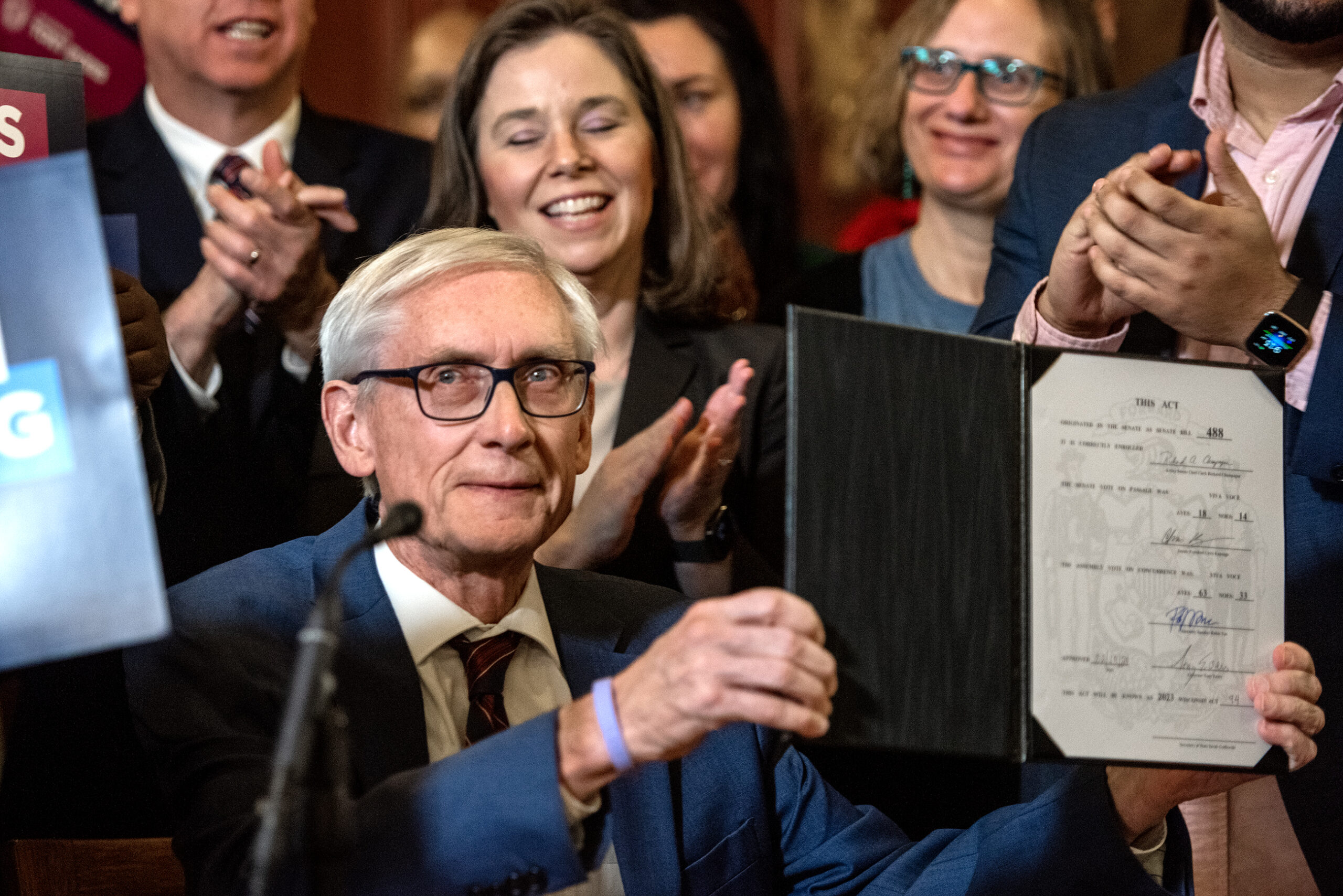For the first time in more than 50 years, the state Legislature and governor reached a bipartisan agreement on new legislative maps, one that could substantially shift the balance of political power in Wisconsin.
The new maps were drawn by Democratic Gov. Tony Evers and passed by Republican lawmakers, who said they’d have a better shot at maintaining their majorities with the governor’s district lines than under other options that were being considered by the Wisconsin Supreme Court’s liberal majority.
With the maps now signed into law, all eyes are on the November election to see how new district lines affect who the voters of Wisconsin send to Madison to represent them.
‘Either party could win’ the Wisconsin Assembly
News with a little more humanity
WPR’s “Wisconsin Today” newsletter keeps you connected to the state you love without feeling overwhelmed. No paywall. No agenda. No corporate filter.
In a nutshell, redistricting experts hired by the court said Evers’ maps are slightly “tilted toward the Republicans” but competitive enough that “the party that wins the most votes will win the most seats” in the Legislature.
Since 2011, that hasn’t been the case in Wisconsin. Under Republican maps drawn that year, and refined in 2021, the GOP majority in the Wisconsin Assembly has swelled to 64-35, a near-supermajority.
Using data from Wisconsin’s 2022 elections, Marquette University Law School Research Fellow John Johnson utilized computer modeling to measure the number of Assembly seats leaning in Republicans’ or Democrats’ favors under the new maps.
If either party has a noticeably good year, then they’ll most likely win the Assembly. And that’s true for Democrats and Republicans.
John Johnson
His data shows 42 assembly districts favoring Democrats by more than 10 percentage points and another four seats favoring Democrats by single digits. It also shows 46 Assembly seats favoring Republicans by more than 10 percentage points, with seven additional seats favoring Republicans by single digits.
In order to win an Assembly majority this November, Johnson said, Democrats would have to win all seats leaning in their favor under the new maps along with seven seats with a slight Republican lean. The most likely targets, he said, include the 61st Assembly District in Milwaukee’s suburbs, the 88th and 89th Districts in the Green Bay Area, the 85th District in Wausau or the 30th District in Hudson.
But, Johnson stressed, the past is not prologue. He said Wisconsin’s 2022 election results do not predict what might happen this fall.
“It’s genuinely either party could win,” Johnson said. “I think that’s what the biggest takeaway is. If either party has a noticeably good year, then they’ll most likely win the Assembly. And that’s true for Democrats and Republicans.”

Senate flip is unlikely in November, but ‘very much in play’ in 2026
Republicans currently hold 22 out of 33 state Senate seats, a two-thirds supermajority. And while GOP lawmakers could lose some seats in 2024, their majority is likely very safe.
Unlike representatives, who are elected every two years, senators serve four-year terms, and their elections are staggered. That means even-numbered districts will be up for election in November and odd-numbered districts will be on the ballot in 2026.
Johnson said because only half of the districts will be contested this year, he essentially sees no chance of Democrats gaining a majority in that chamber this go-round.
“But, you could bet real money that they’re gonna end the supermajority that Republicans currently have,” Johnson said. “They need to flip one seat to do that and they have three likely pickups.”
But 2026 could be a different story.
To flip the Senate under Evers’ maps, Johnson’s analysis suggests Democrats would need to win 10 seats favoring their party by more than 10 percentage points, six seats favoring Democrats by single digits and an additional seat with a slight Republican lean. If they pick up a few seats in November, according to his analysis, it “will put the Senate majority very much in play during the 2026 cycle.”
43 incumbents, mostly Republicans, will be paired against one another
Even as they voted in support of Evers’ maps, Republican lawmakers accused the governor of targeting their party by drawing dozens of GOP incumbents into the same districts.
A court filing by lawyers representing the Legislature says 35 Republicans will be drawn out of their districts and paired with other GOP incumbents. Evers’ maps, they said, pair only seven Democrats together.
The court-appointed consultants that analyzed proposed maps in the redistricting lawsuit wrote that having more Republican pairings is to be expected, “simply because we start with many more Republican incumbents.”
Some Republicans have already announced intentions to do whatever it takes to continue representing their districts despite the new boundaries.
A statement from State Rep. Nate Gustafson, R-Fox Crossing, who has said Evers drew his home 15 feet outside of the 55th Assembly District’s new lines, has announced he plans on “earning enough votes to allow me to continue the important work of making Wisconsin the best place in the Midwest to live and work.”
In the 8th Senate District in Milwaukee’s suburbs, Sen. Dan Knodl, R-Germantown, told WisPolitics he won’t seek reelection to the district but may run for another office. Knodl was drawn into the same district as Sen. Duey Stroebel, R-Saukville, who announced he is running for Senate in the 8th District.

What about special elections before the new maps take effect?
While the maps signed into law this week may seem like the end of Wisconsin’s redistricting saga, there are still questions about what districts state legislative candidates might run in between now and November.
A line at the end of the 165-page maps bill specifies they won’t apply to “special or recall elections” held before then. That prompted some Democratic lawmakers to accuse Republicans of trying to protect Assembly Speaker Robin Vos, R-Rochester, if a push by conservative foes to recall him from office succeeds. But that effective date was added to the maps bill by Wisconsin’s Legislative Reference Bureau, not Republicans.
Gov. Evers has submitted a motion to the state Supreme Court asking justices to keep the redistricting case open because of unsettled questions about what maps should apply for “at least one special election” to fill a 4th District Senate Seat. The seat was held by Sen. Lena Taylor, D-Milwaukee, who resigned from office after Evers appointed her as a Milwaukee County Circuit Court judge.
Another lawsuit could change change state congressional maps
While the battle over new state legislative maps is nearing an end, a new lawsuit challenging Wisconsin’s eight congressional districts is still waiting for potential action by the Wisconsin Supreme Court.
The suit, which was filed by a high-profile Democratic law firm, hinges on a finding by justices in the legislative redistricting case, where the liberal majority rejected the “least changes” rationale used by the court’s conservative majority two years earlier. Under that approach, the court’s conservatives chose both legislative and congressional maps that were similar to the ones Republicans drew in 2011.
For more on the history of redistricting in Wisconsin and how it impacts political power in the state, check out WPR’s investigative podcast series, “Mapped Out.”
Wisconsin Public Radio, © Copyright 2026, Board of Regents of the University of Wisconsin System and Wisconsin Educational Communications Board.


